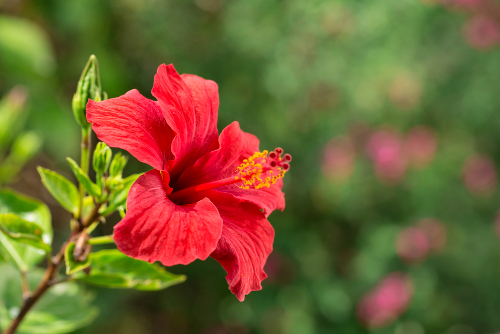Hibiscus (Hibiscus species) is a group of over 600 flowering plants in the mallow family. The best known species are probably Hibiscus syriacus and Hibiscus rosa-sinensis, with their big, colorful, showy blooms.
Other species are used for making tea, or as folk medicine. While some relatives of the hibiscus are native to Europe, the majority of actual hibiscus species grow best in warm, tropical areas.
This means that they don’t have a very long history of use in traditional European witchcraft. Nonetheless, these beautiful plants have found a place in the herb cabinets of green and kitchen witches all over the world.
Magical Properties of Hibiscus
Hibiscus is known as a flower of passion. The red flowers are particularly useful for love spells. These are sometimes burned as an incense in the bedroom to increase the passion between two partners.
The flowers may also be used for divination. Keeping fresh flowers in the bedroom, or placing dried flowers under the pillow, is said to bring prophetic dreams.
These flowers are associated with the goddesses Venus, Aphrodite, and Kali. They are ruled by the planet Venus and the element of water. Astrologically, they are associated with Aquarius and Scorpio.
Benefits & Uses of Hibiscus
Medicinally, hibiscus is often drunk as an infusion to help lower blood pressure. Interestingly, this may be one source for its aphrodisiac properties — many cases of sexual dysfunction trace back to hypertension, in which case a blood pressure-lowering herb would be a fantastic remedy!
Similarly, hibiscus may help improve blood lipid levels and boost liver health.
Modern research shows that an extract of hibiscus given to people with a group of symptoms known as metabolic syndrome helped to lower their blood sugar, reduce low density lipoprotein (LDL, or “bad”) cholesterol, increase high density lipoprotein (HDL, or “good”) cholesterol, and improved insulin resistance.

Some of its other folk uses point to a generally cooling and anti-inflammatory effect. Some sources indicate that it can help soothe an irritated urinary tract, calm an upset stomach, support the immune system, and generally help prevent edema.
A hibiscus relative, the rose mallow, was used to make the first marshmallows. The roots are very high in a slippery compound called mucilage that helps coat and moisturize mucous membranes. This was used to make marshmallows, which were originally used to soothe sore throats.
Possible Risks & Side Effects of Hibiscus
As with any herb, allergies are possible. Symptoms of an allergy may vary widely, and include rashes, itching or swelling of the lips or tongue, or anaphylaxis.
If you’re allergic to hibiscus or other members of the mallow family, substitute in a different herb. For most love spells, red roses would be suitable.
Since hibiscus may lower blood pressure, people with low or normal blood pressure shouldn’t consume too much of it. Doing so can cause hypotension, when blood pressure drops to unsafe levels. This may cause dizziness and fainting. Moderate consumption in otherwise healthy people is safe.
Hibiscus can interact with some medications. Always do your research about consuming herbs if you’re taking any prescription drugs.
Hibiscus History & Folklore
Though hibiscus doesn’t have a long history in European witchcraft, it’s an important plant in its native habitat. In Hawai’i and the Caribbean, hibiscus is used for adornment, and an expression of welcome and hospitality.
In India, the bright red flowers are associated with the goddess Kali. Red is the color of primal power, which is her domain. It’s also associated with the god Ganesha, who taught that the flowers could help humans connect with the divine.
In the Philippines, there’s an interesting origin story for the hibiscus flower. A man fell in love with a nature spirit named Mula. Though their love was forbidden, they couldn’t bear to be apart from each other. The gods sent a demon to punish the lovers, and this demon stabbed the man to death.
When Mula discovered his body, she was heartbroken. Taking up the dagger used to kill her lover, she stabbed herself so she could die by his side. The two lovers were absorbed into the earth, and a hibiscus bush grew where they died.
In China, the hibiscus symbolizes fame and wealth. In South Korea, it represents immortality.
Getting Started With Hibiscus
If you don’t live in a tropical climate, your options for growing hibiscus are a bit limited. A few species are known as “hardy hibiscus,” and can be suitable for growing in cooler climates.
If you have a sun room, you can also grow some hibiscus species as indoor plants. They will bloom indoors as well as out. Otherwise, hibiscus is easy to come by as dried flowers. These can be purchased from any shop that sells bulk herbs or loose teas.
Brew them with other passion-promoting herbs for an aphrodisiac drink, or include the dried flowers in love-drawing spells. (They make a particularly striking addition to love jars.)
While hibiscus isn’t as magically versatile as some other herbs, it packs a punch in the love and passion department. Try this tart, slightly citrusy tea as an offering to love goddesses, sip it to enhance your own feelings, or offer it to a lover. It’s as delicious and healthful as it is magical.
